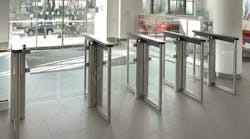Oct. 13--Not even the bucolic Berkeley hills are immune to security concerns in a post-Sept. 11, 2001, world, as the editor in chief of Wired magazine has discovered.
Chris Anderson, a 45-year-old Berkeley resident and aerial-reconnaissance enthusiast, sparked a minor security scare Sunday when his remote-controlled plane -- equipped with a camera -- crashed into a tree at Lawrence Berkeley Laboratory.
Security personnel apparently didn't notice the plane until Anderson asked for help retrieving it, but they've since paid attention.
UC Berkeley police are investigating and federal authorities may be notified about the breach at the hillside lab, which is owned by the U.S. Department of Energy and managed by the university. Unlike UC-managed labs at Livermore and Los Alamos, Berkeley is not involved with nuclear weapons and does not conduct classified research.
It does have important equipment that needs to be protected, said Dan Lunsford, who manages lab security.
"I think, post-9/11, when we see an event that is out of the ordinary, those are things that gain our interest," Lunsford said. "The greatest thing right now in the war on terrorism is prevention."
Anderson, who lives within walking distance of the lab, does not appear to have broken any laws, Lunsford said.
In fact, Anderson said, firefighters helped him get the 4-ounce foam plane back when he came calling at the lab's front gate.
"They were incredibly nice about it," he said.
The flight was an attempt to take photos of the unusual architecture of the lab's cyclotron, a mostly round particle accelerator. The photos were to be posted on his personal Web site, diydrones.com, devoted to unmanned aerial vehicles, or drones.
Instead, Anderson, whose children took turns piloting the plane, ended up with a partial photo of the cyclotron and a blog entry titled: "Lesson: Don't fly planes over secure national labs!"
Anderson, who worked at Los Alamos lab in New Mexico, acknowledged he should have known better than to take the close-up aerial photos.
"I promise not to fly over secure national labs anymore," he said.
Lunsford said he would rather be safe than sorry.
"What could have been simply someone having fun in the hills of Berkeley has become an incident that we just want to validate as harmless," Lunsford said.
"There was no cloak-and-dagger stuff here. But we're going to err on the side of safety."

